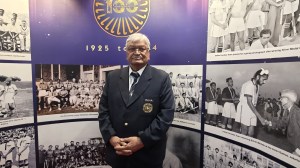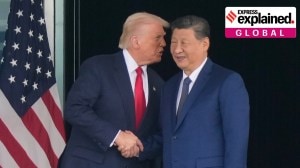INDIA BEAT
Call it the Pearl and Perry effect. The foreign correspondent in the subcontinent has suddenly become the subject — no longer is he (or...

Call it the Pearl and Perry effect. The foreign correspondent in the subcontinent has suddenly become the subject — no longer is he (or she) the quiet India hand in thcae public imagination, unobtrusively flitting from a religious congregation on the banks of the Ganges to a refurbished palace in Rajasthan, with the occasional detour through a colourful electoral campaign in some otherwise sleepy village. Wall Street Journal reporter Daniel Pearl’s last days, as he journeyed into Pakistan from his Mumbai home, seeking to gain entry into the jehadi establishment but ending up the protagonist of a gruesome home video, highlighted to the world beyond the logistics of the South Asia correspondent’s beat. It was a tragic lesson in globalisation for readers and viewers across the world: South Asia was no longer merely the land of gaudy marriages and brutal poverty, it was also being wracked by forces of terrorism that threatened folks continents away.
Months later, as Alex Perry of Time magazine squinted away under the camera lights as he answered summons and sought to explain why he possessed two British passports, Indians once again got tidings of their traditional touchiness. Those foreigners reporting out of this ancient land may get their facts wrong so very often, but, oh, how it animates us — how we love to track their opinions about us.
But who are these men and women sending ever longer despatches back home? How has their job profile changed as India opened its doors and then gatecrashed into the nuclear club? A chat with some leading India hands:
Man of the Moment
Alex Perry,
South Asia bureau chief, Time, April 2002
Perry, a product of Oxford University, joined Time as a staff writer and travel editor in Hong Kong in 2001.
Bollywood Dreams
Catherine Philp,
The Times, London,September 2001
‘‘Earlier, the stories on India that generated interest in the British media were less political and more cultural in nature. But since September 11, there has been a lot of interest in this geo-political region… You cover six countries on this posting, so it’s a promotion.’’
A self-confessed Bollywood fan, Philp says, ‘‘You can’t create interest in an area in a vacuum. Devdas is playing all over London, and non-Asians are also interested in the film and the culture. So, the world has woken up to India like never before.’’
He Stayed On
John Elliott,
South Asia bureau chief, Financial Times, 1983-88, now contributes to Fortune
And he had more than enough to occupy him. ‘‘The 1980s were a fascinating time to cover India. So many changes, political as well as economic. They made great stories for FT. Also, I remember that those days one had to do a lot of aggressive travelling, especially to get stories from the heartland such as Bihar or Uttar Pradesh.’’
Having had enough of journalism in 1988, Elliott went to Hong Kong as advisor to the chief secretary. He returned to India in 1995, did a three-month fellowship with the Rajiv Gandhi Foundation, and now contributes to several foreign papers.
The Newly Arrived
DAVID ROHDE,
The New York Times, South Asia bureau chief with Amy Waldman, July 2002
ROHDE, too, is accustomed to occasional brushes with fame. As an American reporter for the Christian Science Monitor, Rohde hit the headlines twice in 1995, first after discovering one of the mass graves left by Serbs in Srebenica and again when Serbs captured him at gunpoint and held him captive for 10 days. It took concerted diplomatic efforts to secure his release. In March 1996, Rohde was awarded the George Polk Award for foreign reporting; a month later, he received the Pulitzer for international reporting and the three-part series on his work in Bosnia. Says outgoing NYT bureau chief Barry Bearak: ‘‘I worked with him in Bosnia and he’s a very hardworking reporter and a wonderful person. He has a keen eye for detail and is thorough with his research. I’m sure he will have a great time here.’’
Radioactive Years
Celia Dugger and Barry Bearak,
co-bureau chiefs, The New York Times, 1998-2002
| Barry Bearak and Celia Dugger: ‘We came here in the aftermath of the nuclear hysteria and learnt a lot’ |
REFERRED to as a reticent and asocial journalist couple by the foreign correspondents’ fraternity, Dugger and Bearak say the last four years have been tough, but a great learning experience. Bearak says India was the couple’s first choice for an outstation posting. ‘‘We came here in the aftermath of the nuclear hysteria. I have gained a lot from this assignment. We were really looking forward to our assignment in India.’’ Bearak won the 2002 Pulitzer Prize for international reporting for his coverage of the conflict in war-torn Afghanistan.
Slow Acquaintance
Luke Harding,
The Guardian, South Asia bureau chief, February 2000
| Luke Harding: ‘Things were pretty slow earlier, now I am insanely busy’ |
He is entitled to sound a little breathless. ‘‘I missed the Pokhran II nuclear tests and Kargil, so when I came here in February 2000, things were pretty slow for the first six months,’’ says Harding. ‘‘I wrote a lot of magazine features, and then with the Gujarat earthquake, things became more busy and then with 9/11 and the Gujarat violence, things have become insanely busy. So much so that I haven’t been eating and sleeping properly.’’
His reward: occupancy on the front page. ‘‘Foreign news editors seem to have woken up to a new India about two years ago. India has been on the front page of The Guardian for some months now.’’
Harding, 34, read English literature at Oxford before joining The Guardian, initially reporting on the royal family and tracking domestic news. On India, he’s noticed a distinct change in perspective. He feels that while in the ’80s correspondents couldn’t get over a Raj hangover, today they are covering a new, more open India, be it the software revolution, call centres or communal flare-ups.
Trend Setter
Brooke Unger,
South Asia bureau chief, The Economist, May 1998
| Been There, Done That |
|
Some India correspondents who went on to bigger things JOSEPH LELYVELD, The New York Times Story continues below this ad STEVE WEISMAN, South Asia bureau chief, The New York Times, 1985-89 JOHN F. BURNS, South Asia bureau chief, 1997-2000, The New York Times, currently the Islam correspondent based in London |
CALL it coincidence, but in May 1998, just a week before the Buddha smiled again, The Economist decided to station a full-time correspondent in India. Recalls Unger, who flew into the thick of things: ‘‘The nuclear tests marked a sea change for India. I think Clinton’s visit in March 2000 was a turning point. It’s been a hectic, but exciting, time for me’’
Unger, an American on the rolls of a very British publication, had visited India as a tourist before being posted here, and was captivated. He opted for India as he wanted to work on feature stories on the subcontinent. ‘‘India is being noticed by the world as never before for the past two years, for reasons good and bad,’’ says the man now preparing for his next assignment in Brazil. ‘‘My impression is that after the Middle-East, South Asia is the most exciting news beat. It’s been a lively four years.”
It’s not Jerusalem
Ian Mackinnon,
Correspondent with The Daily Mail and The Australian, 1997
MACKINNON, an American, began his stay in New Delhi seven years ago reporting for The Independent, London. ‘‘India is not a first rank foreign destination, say on the lines of Jerusalem,’’ he clarifies. ‘‘Nevertheless it’s a very exciting beat and has definitely moved up the agenda. However, things are changing, and the past three years have been very busy. A lot of American organisations have sent correspondents, and the Chicago Tribune has shut their Tokyo bureau and has opened one in New Delhi. (Liz Sly will be arriving in New Delhi as the South Asia bureau chief.) But I have continued to stay here essentially because India has such a vibrant culture, as opposed to Europe or Britain which are very grey areas for a reporter.”
Shades of Residency
David Housego,
South Asia bureau chief, Financial Times, 1988-91
HE hit the headlines in June 1994, when his 16-year-old son was kidnapped by the Harkat-ul-Ansar in Pahalgam in an effort to secure the release of Maulana Masood Azhar.
After a stint with The Economist, he joined Financial Times as the Asia correspondent based in London in 1976. ‘‘That was the time that I came to India a lot,’’ he recalls, ‘‘as the Emergency had ended and the Janata Party was in power. It made for good political stories which the British loved to read. I never felt the language barrier in South Asia.’’ When his tenure as bureau chief ended, Housego and his wife stayed on in New Delhi to set up a textile export house, Shades of India.
|





- 01
- 02
- 03
- 04
- 05


























